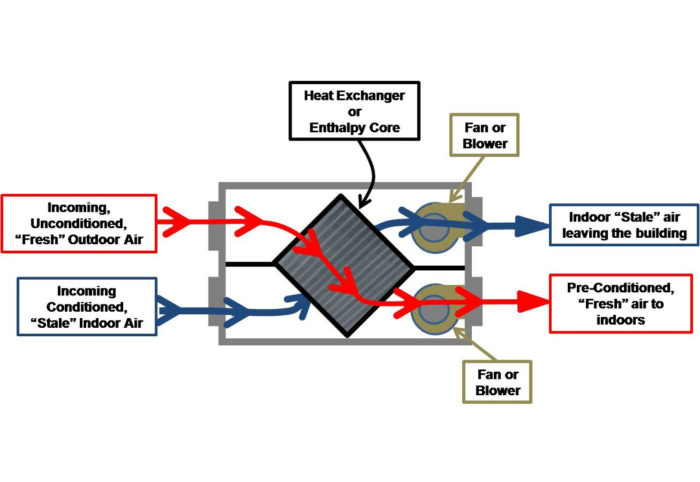Discovering the Conveniences of Heat Recovery Ventilation for Power Performance in Residences
Heat Recovery Ventilation (HRV) systems supply home owners a sensible strategy to boosting energy performance. By recovering heat from outgoing air, these systems can considerably decrease cooling and heating costs. In addition, they offer a constant supply of fresh air, improving indoor air high quality and convenience levels. As home owners think about sustainable options, understanding the nuances of HRV systems becomes progressively crucial. What aspects should one evaluate before making such a financial investment?
Recognizing Heat Recovery Ventilation Systems

How HRV Boosts Indoor Air Quality

Energy Financial Savings: The Economic Advantages of HRV
Making the most of energy effectiveness, heat recovery ventilation (HRV) systems provide significant monetary advantages for home owners. By recovering and reusing warm from exhaust air, HRVs considerably decrease heating & cooling costs. This innovation can result in energy savings of approximately 30%, depending upon environment and use patterns. House owners commonly observe minimized energy expenses shortly after installation, making HRVs an economically sensible financial investment gradually. Furthermore, numerous areas offer rewards or discounts for energy-efficient upgrades, better improving the economic appeal. As power rates continue to increase, the cost-effectiveness of HRVs becomes significantly clear. Overall, the consolidation of HRV systems not just promotes energy performance yet also adds to long-lasting monetary reference savings for homes.
The Ecological Impact of Heat Recovery Ventilation
A considerable ecological benefit of heat recovery ventilation (HRV) systems depends on their ability to decrease total energy usage. By recovering warm from exhaust air and moving it to incoming fresh air, HRV systems decrease the requirement for energy-intensive heating and cooling down methods. This decrease in energy need contributes to reduce greenhouse gas exhausts, as less nonrenewable fuel source is required to keep comfortable interior temperatures. In addition, HRV systems enhance indoor air top quality by efficiently exchanging stale air with fresh outside air, lowering reliance on mechanical cooling systems that can damage the setting. Overall, the execution of HRV systems sustains lasting living techniques and aligns with global efforts to battle environment adjustment by advertising power performance in residential setups.
Selecting the Right HRV System for Your Home
Exactly how can home owners assure they choose the appropriate heat recovery ventilation (HRV) system for their demands? They ought to analyze their home's dimension and design, as these aspects influence airflow requirements. Next off, like it examining the system's performance scores is crucial, as greater ratings suggest better efficiency and energy cost savings. Property owners ought to additionally think about installation and upkeep prices, contrasting different brands and models for value. In addition, it is essential to assess noise degrees, as some systems run more quietly than others. Consulting with cooling and heating professionals can provide tailored suggestions based upon details home problems. Finally, analyzing individual testimonials and guarantees can aid in making an informed decision, guaranteeing that the chosen HRV system effectively boosts indoor air top quality and power performance.
Often Asked Inquiries

Exactly how Commonly Should I Clean or Preserve My HRV System?
The regularity of cleansing or keeping a warm healing air flow (HRV) system typically depends on usage and environmental aspects. Generally, it is advisable to do upkeep every six months to assure peak performance and air top quality.

Can HRV Equipments Assist Minimize Humidity Degrees Inside?
HRV systems can successfully decrease interior humidity levels by exchanging stale, damp air with fresh, drier air from outdoors. HRV Heat Recovery Ventilation. This process browse around this web-site helps preserve a balanced indoor environment, improving comfort and preventing moisture-related problems
What Is the Life-span of a Regular HRV System?
The lifespan of a common heat recovery ventilation (HRV) system varies, usually lasting between 10 to 15 years. Normal maintenance can prolong its efficiency and operational life, making certain peak performance throughout its usage period.
Are There Any Noise Worry About HRV Solutions?
Noise worry about HRV systems can occur, especially from fan procedure. Numerous modern systems are designed to minimize audio levels, ensuring they run quietly while preserving effectiveness, which resolves possible disruptions in living atmospheres.
Can I Set Up an HRV System Myself, or Do I Required a Specialist?
The private contemplated whether to install the heat recovery ventilation (HRV) system directly or hire a specialist. Typically, while DIY setup is possible, expertise guarantees proper performance and compliance with local structure codes, improving system efficiency.